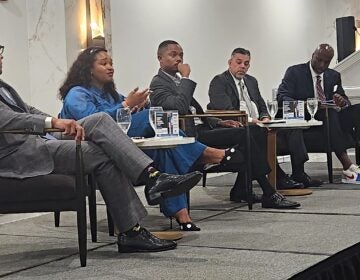Commentary: Why NJ’s School Funding Reform Act of 2008 failed and where we go from here
Two things are certain about New Jersey’s politics in 2018. One, New Jersey will have a new governor. Two, the Pension Crisis means that the new governor will be just as unable to fully fund New Jersey’s school funding law as Chris Christie was.
Yet, as grim as the pension crisis is for schools, there is hope if New Jersey can redistribute hundreds of millions of dollars from school districts that receive more money than the aid law says they need.
New Jersey’s school funding law is called SFRA – the School Funding Reform Act of 2008. SFRA was passed in January 2008 as an attempt to finally make New Jersey’s distribution of state aid progressive, fair, and predictable. SFRA was supposed to level the enormous state aid gaps between high-need/low-resource non-Abbotts like Prospect Park, Guttenberg, Belleville, Lakewood, Dover etc and their demographic Abbott peers whose state aid is 2-4 times as high. SFRA was supposed to end the Abbott-district monopoly on state funded Pre-K so that poor children in scores of high-need non-Abbotts would have a better chance at being kindergarten-ready. Finally, SFRA was finally supposed to provide some tax relief and budgetary assistance to severely overtaxed suburbs, whose own poverty rates were increasing, school spending often average, and whose residents were taxed to their maximum.
However SFRA was a method of distributing new aid and not a redistribution of the existing aid stream. In order to prevent any redistribution of aid — especially from Abbott districts — SFRA contained a provision for something titled “Adjustment Aid.” Adjustment Aid guarantees that any district for whom the new SFRA aid calculations give less aid than it got under the previous funding law that it would be “held harmless” and could keep their old aid.
If New Jersey had experienced economic and revenue growth after 2008 and the state could pour an additional $2 billion a year into SFRA, New Jersey’s school districts might finally have fairness based on needs and resources, but the reality is that SFRA was signed at New Jersey’s peak employment. The recession hit the next year and Jon Corzine himself and later Chris Christie slashed over $1 billion in funding from New Jersey’s public schools.
And now even though the recession has been over for over five years, New Jersey has no chance of fully funding SFRA now and the ideology of the next governor is irrelevant.
The reason for this is plain: the Pension Crisis. New Jersey’s unfunded pension liabilities verge on being unpayable – $82.7 billion as of mid-2014. For FY 2013, New Jersey’s pension funds paid out $9.1 billion in pension benefits but only received $4.6 billion in contributions from the state, localities, and active employees. The $4.5 billion gap means that the pension funds are rapidly depleting and will start to “zero-out” within a decade. According to Moody’s, even if the pension funds hit their 7.9 percent investment goal (which they didn’t in 2014), the Judicial Retirement System will go broke in 2021, then the Police and Firemen’s Retirement System and the state portion of PERS in 2024, and then the biggest fund, the Teachers’ Pension and Annuity Fund (TPAF) will go broke in 2027.
In 2011 the legislative Democrats tried to fully fund SFRA with proceeds from a “Millionaire’s Tax,” but Christie vetoed the tax. Now, in the era of the Pension Crisis, the Democrats have stopped purporting to want to fully fund SFRA. The latest versions of the “Millionaire’s Tax” would have sent all of the revenue to the pension system, not the schools.
Now after years of recession and frozen state aid, New Jersey’s aid distribution is more unfair than ever. Adjustment Aid is $555 million of undisguised aid hoarding that immensely benefits most of the Abbotts, many Shore districts, many rural districts, and especially Hoboken and Jersey City. Adjustment Aid’s “hold harmless” designation looks like an Orwellian attempt to distract that fact that low-income non-Abbotts like Prospect Park, Guttenberg, Belleville, Lakewood, Dover plus many middle-resource districts are absolutely harmed by it.
The fact that SFRA is only a method of distributing new aid and the state has no new aid to distribute, SFRA “does not breathe” and the old, unfair, and irrational aid distribution persists. The promise of more aid to low-income non-Abbotts has not been kept and due to the Pension Crisis cannot be kept unless SFRA’s prohibition on redistribution is changed.
Since the state cannot put significant new money into education and may even have to cut the $8.6 billion it already pays out we need to start a conversation about redistributing education aid. The reality of flat or declining aid streams means that state aid is more zero-sum than ever before. Every dollar of Adjustment Aid that Hoboken, Jersey City, Shore districts, and many rural districts cling to is one dollar available less for districts with much more acute need. Every dollar that goes to Interdistrict Choice is one dollar less available to non-Choice districts that likely have growing residential enrollments. Every dollar that goes to provide “free” Pre-K to affluent children in Jersey City and Hoboken is taken away from Pre-K for disadvantaged children living outside the Gold Coast Abbott Pre-K bubble.
Since the Pension Crisis prevents New Jersey from having a fair aid distribution through making the pie larger, so we have to divide the pie more fairly. A district that has gentrified as Jersey City has – which has a $109 million school tax levy on $18.3 billion in official valuation plus billions more hidden behind tax abatements – can pay much more for its own schools and allow its aid to be freed up to help needier districts. It also means that the state finally has to show pragmatism even with non-gentrified Abbott districts, whose aid has risen from 45% of the distribution in 1997 to 60 percent of the distribution now, even though their share of the student population has fallen below 20 percent.
In passing SFRA the state decided how to spend a larger aid package, but with the pension debt tidal wave looming up in front of us we need to decide how to spend a flat or smaller aid package. Although no district likes to lose aid, the reality is that over 200 districts are already overaided according to SFRA and have greater capacities for absorbing cuts than other districts. Adjustment Aid and “free” Pre-K in gentrified Abbotts should be seen as problems; allowing them to exist when so many other districts are severely underaided and underfunded means that in New Jersey some children are more equal than others.
_____________________________________________________________
Jeffrey Bennett is the member the South Orange-Maplewood Board of Education in Essex County. The views herein are solely his own. He blogs at New Jersey Education Aid.
WHYY is your source for fact-based, in-depth journalism and information. As a nonprofit organization, we rely on financial support from readers like you. Please give today.




